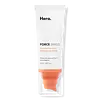What's inside
What's inside
 Key Ingredients
Key Ingredients

 Benefits
Benefits

 Concerns
Concerns

No concerns
 Ingredients Side-by-side
Ingredients Side-by-side

Zinc Oxide
Cosmetic ColorantWater
Skin ConditioningCaprylic/Capric Triglyceride
MaskingPropanediol
SolventC13-15 Alkane
SolventC15-19 Alkane
SolventButyloctyl Salicylate
Skin ConditioningBis-Diglyceryl Polyacyladipate-2
EmollientOctyldodecanol
EmollientCetearyl Alcohol
EmollientPolyacrylate Crosspolymer-6
Emulsion StabilisingHippophae Rhamnoides Oil
EmollientBetaine
HumectantMica
Cosmetic ColorantMusa Sapientum Leaf Extract
Skin ConditioningSilica
AbrasiveCoco-Glucoside
CleansingArachidyl Alcohol
EmollientXanthan Gum
EmulsifyingPolyhydroxystearic Acid
EmulsifyingPolyglyceryl-3 Polyricinoleate
EmulsifyingIsostearic Acid
CleansingLecithin
EmollientPolyglyceryl-3 Lactate/Laurate
CleansingPolyglycerin-3
HumectantBisabolol
MaskingTocopherol
AntioxidantBehenyl Alcohol
EmollientCaprylhydroxamic Acid
Sodium Dilauramidoglutamide Lysine
HumectantCitric Acid
BufferingArachidyl Glucoside
EmulsifyingEctoin
Skin ConditioningNiacinamide
SmoothingMaltodextrin
AbsorbentSodium Citrate
BufferingSodium Phytate
Terminalia Ferdinandiana Fruit Extract
AntioxidantLactobacillus Ferment
Skin ConditioningTin Oxide
AbrasiveGlucose
HumectantLeuconostoc/Radish Root Ferment Filtrate
AntimicrobialCI 77492
Cosmetic ColorantCI 77491
Cosmetic ColorantTitanium Dioxide
Cosmetic ColorantZinc Oxide, Water, Caprylic/Capric Triglyceride, Propanediol, C13-15 Alkane, C15-19 Alkane, Butyloctyl Salicylate, Bis-Diglyceryl Polyacyladipate-2, Octyldodecanol, Cetearyl Alcohol, Polyacrylate Crosspolymer-6, Hippophae Rhamnoides Oil, Betaine, Mica, Musa Sapientum Leaf Extract, Silica, Coco-Glucoside, Arachidyl Alcohol, Xanthan Gum, Polyhydroxystearic Acid, Polyglyceryl-3 Polyricinoleate, Isostearic Acid, Lecithin, Polyglyceryl-3 Lactate/Laurate, Polyglycerin-3, Bisabolol, Tocopherol, Behenyl Alcohol, Caprylhydroxamic Acid, Sodium Dilauramidoglutamide Lysine, Citric Acid, Arachidyl Glucoside, Ectoin, Niacinamide, Maltodextrin, Sodium Citrate, Sodium Phytate, Terminalia Ferdinandiana Fruit Extract, Lactobacillus Ferment, Tin Oxide, Glucose, Leuconostoc/Radish Root Ferment Filtrate, CI 77492, CI 77491, Titanium Dioxide
Water
Skin ConditioningMethylpropanediol
SolventGlycerin
Humectant1,2-Hexanediol
Skin ConditioningButylene Glycol
HumectantCentella Asiatica Extract
CleansingAnthemis Nobilis Flower Extract
MaskingHouttuynia Cordata Extract
Skin ConditioningCamellia Sinensis Leaf Extract
AntimicrobialPortulaca Oleracea Extract
Skin ConditioningRosmarinus Officinalis Leaf Extract
AntimicrobialRosmarinus Officinalis Leaf Oil
MaskingSalix Alba Bark Extract
AstringentFicus Carica Fruit Extract
HumectantMentha Rotundifolia Leaf Extract
TonicCeramide NP
Skin ConditioningOctyldodeceth-16
EmulsifyingHydroxyacetophenone
AntioxidantSodium Citrate
BufferingEthylhexylglycerin
Skin ConditioningPentylene Glycol
Skin ConditioningCitric Acid
BufferingHydrogenated Lecithin
EmulsifyingEthyl Hexanediol
SolventTocopherol
AntioxidantWater, Methylpropanediol, Glycerin, 1,2-Hexanediol, Butylene Glycol, Centella Asiatica Extract, Anthemis Nobilis Flower Extract, Houttuynia Cordata Extract, Camellia Sinensis Leaf Extract, Portulaca Oleracea Extract, Rosmarinus Officinalis Leaf Extract, Rosmarinus Officinalis Leaf Oil, Salix Alba Bark Extract, Ficus Carica Fruit Extract, Mentha Rotundifolia Leaf Extract, Ceramide NP, Octyldodeceth-16, Hydroxyacetophenone, Sodium Citrate, Ethylhexylglycerin, Pentylene Glycol, Citric Acid, Hydrogenated Lecithin, Ethyl Hexanediol, Tocopherol
 Reviews
Reviews

Ingredients Explained
These ingredients are found in both products.
Ingredients higher up in an ingredient list are typically present in a larger amount.
Citric Acid is an alpha hydroxy acid (AHA) naturally found in citrus fruits like oranges, lemons, and limes.
Like other AHAs, citric acid can exfoliate skin by breaking down the bonds that hold dead skin cells together. This helps reveal smoother and brighter skin underneath.
However, this exfoliating effect only happens at high concentrations (20%) which can be hard to find in cosmetic products.
Due to this, citric acid is usually included in small amounts as a pH adjuster. This helps keep products slightly more acidic and compatible with skin's natural pH.
In skincare formulas, citric acid can:
While it can provide some skin benefits, research shows lactic acid and glycolic acid are generally more effective and less irritating exfoliants.
Most citric acid used in skincare today is made by fermenting sugars (usually from molasses). This synthetic version is identical to the natural citrus form but easier to stabilize and use in formulations.
Read more about some other popular AHA's here:
Learn more about Citric AcidSodium Citrate is the sodium salts of citric acid. In skincare, it is used to alter pH levels and acts as a preservative.
Its main functions are to maintain the pH of a product and neutralize metal ions.
The acidity of our skin is maintained by our glands and skin biome; normal pH level of skin is slightly acidic (~4.75-5.5).
Being slightly acidic allows our skin to create an "acid mantle". This acid mantle is a thin barrier that protects our skin from bacteria and contaminants.
Learn more about Sodium CitrateTocopherol (also known as Vitamin E) is a common antioxidant used to help protect the skin from free-radicals and strengthen the skin barrier. It's also fat soluble - this means our skin is great at absorbing it.
Vitamin E also helps keep your natural skin lipids healthy. Your lipid skin barrier naturally consists of lipids, ceramides, and fatty acids. Vitamin E offers extra protection for your skin’s lipid barrier, keeping your skin healthy and nourished.
Another benefit is a bit of UV protection. Vitamin E helps reduce the damage caused by UVB rays. (It should not replace your sunscreen). Combining it with Vitamin C can decrease sunburned cells and hyperpigmentation after UV exposure.
You might have noticed Vitamin E + C often paired together. This is because it is great at stabilizing Vitamin C. Using the two together helps increase the effectiveness of both ingredients.
There are often claims that Vitamin E can reduce/prevent scarring, but these claims haven't been confirmed by scientific research.
Learn more about TocopherolWater. It's the most common cosmetic ingredient of all. You'll usually see it at the top of ingredient lists, meaning that it makes up the largest part of the product.
So why is it so popular? Water most often acts as a solvent - this means that it helps dissolve other ingredients into the formulation.
You'll also recognize water as that liquid we all need to stay alive. If you see this, drink a glass of water. Stay hydrated!
Learn more about Water